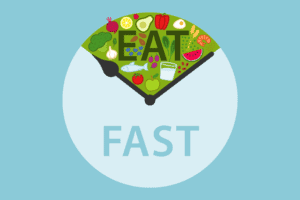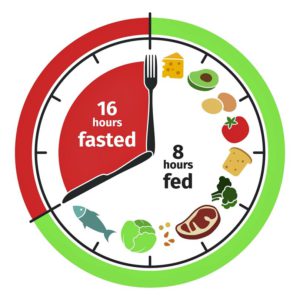OMAD stands for One Meal a Day. The idea is to fast for 23 hours straight and then consume one large meal in a 60-minute window. Lately, OMAD has been gaining popularity, with people swearing it is a weight-loss method. Also, a way to tackle chronic disease and other health issues.
This is the longest form of time-restricted eating, equivalent to a 23:1 fast (fasting for 23 hours and eating in a 1-hour window). In its purest sense, OMAD doesn’t dictate calorie restriction or specific macronutrient composition.
HOW TO START ONE MEAL A DAY DIET
One Meal A Day can be a pretty extreme intermittent fasting schedule. Avoiding food for 23 hours a day takes a lot of extra effort, and creating a situation that stresses you out can undo some of the powerful benefits of fasting.
The goal with one meal a day isn’t to feel like you’re punishing your body or suffering through a challenge.
If you want to start slow, here are a few tips:
- Introduce intermittent fasting every other day, with small snacks after workouts.
- Start by fasting in shorter durations. Get comfortable fasting for 16-20 hours at a time, and slowly build up to fasting for 23 hours a day.
- You can also try one 23:1 day, then add more OMAD days into your weekly routine. As with any style of fasting, it’s important to see how your body responds and find what works for you.
The toughest thing about fasting isn’t trying to power through your hunger — it’s catching yourself before you mindlessly grab a snack and pop it in your mouth.
Like many diets, OMAD has a host of rules. For starters, your one meal should be eaten in the same four-hour time block every day, so you eat on a consistent schedule.
You’re allowed to drink beverages during your 23-hour fast, but they have to be the calorie-free kind, like black coffee or water.
You also must consume your one meal on a standard dinner plate—nothing larger. (Sorry, bowl fans.) And no piling on heaping amounts of food. Whatever you choose to eat can’t rise higher than three inches on your plate.
That’s the upside to OMAD: You don’t really need to consider your calories or worry about the exact nutritional profile of the food you eat, as long as you’re saving all of your calories for that one period of time.
WHAT CAN YOU EAT ON THE OMAD DIET?
- The diet allows you to eat whatever you want. So you should try to make up for the calories you skipped throughout the day, feel free to load up on foods with lots of healthy fats, like avocado, olive oil, and nuts, she suggests.
- Also important: add variety. “Because our nutrient needs are so diverse, a variety would be essential. Mix it up by eating different things every day so you don’t miss out on nutrients,” suggests White.
- Drink a cup of Bulletproof Coffee ( With MCT oil ) in the morning to reap the benefits of fasting without feeling hungry all day.
BENEFITS :
FIGHTS THE EFFECTS OF AGING
The OMAD diet and other intermittent fasting styles activate autophagy your body’s clean-up mode for damaged cells, toxins, and waste.
Autophagy also occurs in neurons of your brain, part of why intermittent fasting diets have been shown in rodent studies to fight age-related neurological disorders such as Alzheimer’s, Parkinson’s, and stroke.
BOOSTS METABOLISM
Fasting also has profound effects on your metabolism because it resets your tolerance to hunger and helps you burn fat longer. In rodent studies, intermittent fasting has been shown to have a beneficial effect on lowering blood sugar and increasing insulin function, both factors in preventing obesity and diabetes.
IMPROVES HEALTH AND PROTECTS AGAINST DISEASE.
Animal studies have linked intermittent fasting to improvements in weight loss, asthma, cardiovascular disease, and inflammation, as well as protection against cancers, neurodegeneration, and diabetes.
SIMPLIFIES MEAL PREPARATION
Among fasting styles, OMAD fasting brings some unique benefits of its own. If you’re only eating one meal, you can leave behind the stress of finding healthy meals at work, on the go, or at restaurants throughout your day. Eating OMAD means you only have to plan for one meal a day, letting you sleep through breakfast and simplifying the grocery plan.
WHEN YOU EAT, YOU’LL EAT LESS
OMAD can also make it easier to manage your weight through natural calorie restriction. You’ll find you aren’t able to comfortably eat your entire day’s calories in one sitting, but you’ll still feel like you’re indulging in a large meal.
CONCERNS ABOUT OMAD:
Chronic caloric restriction
OMAD can then start to look a lot like chronic caloric restriction. Although chronic caloric restriction helps with initial weight loss, it poses long-term concerns because it tends to lower the resting metabolic rate, which makes weight loss very difficult to maintain.
Inadequate protein intake
Just as OMAD promotes caloric restriction, it can also lead to protein restriction. Since protein helps you feel full and satisfied, it can be difficult to eat your entire daily requirement in one sitting.
GI upset and diarrhea
No food followed by a large amount of food causes abdominal discomfort and even diarrhea.









